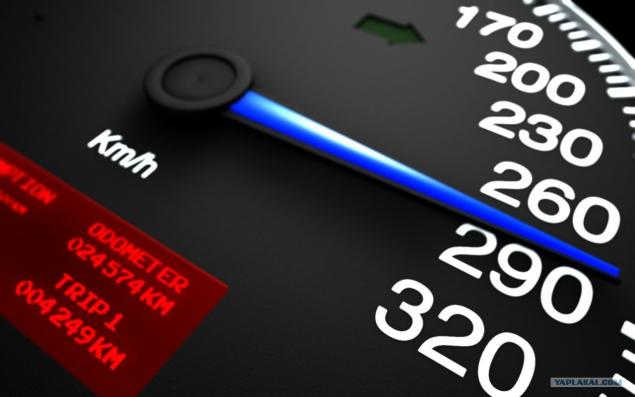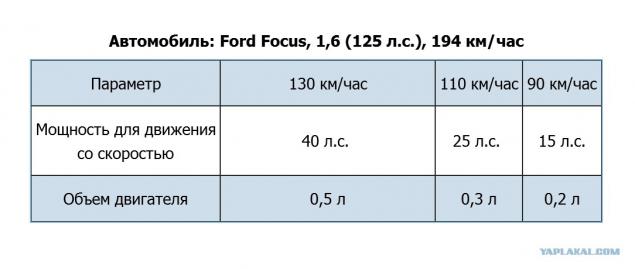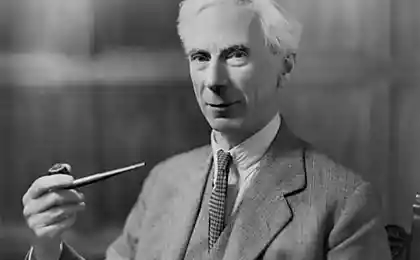522
The paradox with a maximum speed
Imagine that in Russia for some reason were allowed to free sale of weapons ranging from pistols to grenade launchers. But it is strictly forbidden to shoot out of it. Is not it absurd?
The speed limit is 99% of the roads Russia is limited to 90 km / h (1% - 110 km / h), with the most dead car on the market - 51-strong Daewoo Matiz - accelerates to 140 km / h. Lada Granta has a top speed of 170 km / h, while the average foreign car easily transfer any of 180-200 km / h.
What for?

Manufacturers like putting up unreasonable customers revolver in the instructions which says "Do not aim his eyes," and when the next sucker falls dead, saying plaintively: Well, we're warned! And then run by lawyers and politicians from all sorts of acts prohibited to shoot yourself in the eye.
With a maximum speed - both with a gun on stage: if she appeared in the first act of technical characteristics, be sure to shoot the last (sometimes it becomes an act of an accident).
We seem to live in a quiet hope that one morning the road will be no limit, and those extra 60 km / h suddenly needed. But the trend of recent years suggests otherwise: even those countries where there is "aion," think about the introduction of speed limits - this also applies to the German autobahns and roads in the Northern Territory of Australia and a highway in Wales. The civilized world is discussing the idea of lowering the limit even for the sake of delaying energy collapse.
It's not just about security. You will be surprised how the motor should be oversized to provide extra 30-60 km / h maximum speed.
The table below shows the power required to move at different speeds, "Ford Focus", as well as the approximate volume of the engine, which can provide this power.

So the difference is huge because for motion to high speed the car has to overcome the resistance of the air in the main, as required for this power is proportional to the cube of speed. By reducing the maximum speed twice, we reduce the need for power is nearly 8 times (there are nuances, but the whole picture about this).
However, there is a technical problem: Ford Focus with a 40-horsepower engine will accelerate to 100 km / h in 20 seconds, because excess capacity is needed not only for the sake of maximum speed, but also for the normal acceleration.
However, this limitation can be circumvented, if installed on a car battery and a small engine generator: this scheme is used in hybrids. In the current situation it is difficult to compete with conventional internal combustion engines, because people do not want to buy a car for 600 thousand, which is the maximum speed ahead only "Oka" and "Loiseau" - that is the psychology. But if the speed of all vehicles structurally limited 110-130 km / h, the psychological aspect is removed, giving way to rational arguments. For a long ride of 130 km / h rather indicated in Table 40 hp, and an additional 60-70 hp can momentarily "dopinat" electric motor. Feels like a car would be no worse than usual, and with proper engineering even better.
Assume that the speed of the country is limited to 110 km / h. Let our hypothetical Ford Focus has an engine displacement of 0, 6 liters and 50 hp (with a margin). Then, even moving uniformly at the maximum-permitted speed, he has 25 excessive "horses", from which, if necessary, the battery is charging. Acceleration before overtaking takes an average of 30-60 seconds, during which time we want to have a power of 125 hp, as in the current Focus, and electric motors shall issue an additional 75 hp This requires a battery capacity of 1 kWh or 77 Ah. This compares with a capacity of conventional batteries under the hood of the car. A full charge at a speed of 110 km / h will be 3, 5 minutes. In reality, of course, the capacity should be increased, we need a powerful generator, plus there are a number of subtleties that I'm not going to ship you, but there is no insurmountable technical problems.
You tell me that all this is too difficult, but when it comes to the massive use of technology and complexity, and the price will drop. But we will get serious environmental bonus, because now every day, millions of spare pistons are driven millions of liters of air in excess of the working volume. All this dushitsya millions chokes, scattering millions of kilowatts of power. Each car hundred "horses" most of the time idle with nothing to do, because in traffic should be on the strength of five to ten goals. Even in the country line used by 99% of the time only half of the average power of foreign cars, and for top models - a quarter or even less.
At the same time every extra liter of fuel required, even when the car is idling. To ensure a maximum speed of vehicles surplus, which is prohibited by law, we burn an incredible amount of fuel. Is not it absurd?
Additional electric motor - not the only way to make the car on brisk acceleration. Certain reserves are hidden in fashion now turbo engine with "tractor" traction characteristics that have moderate capacity, but a huge moment at low speeds, providing a steady acceleration and low top speed. Something that can be squeezed out by the selection of gear ratios, because "short" speed range would be easier to cut into the transmission.
And the easiest way - to release the motors capable of enhancing power only briefly, for example, due to high speed or supercharging. They will need to accelerate to speed, but to give high power all the time - no.
In general, the maximum speed of the forbidden fruit creates many contradictions: first, automakers are investing billions of euros to improve the aerodynamics of the car at a speed of 150 km / h, and then the Russian traffic police to invest billions of rubles in a promotional video that explains the inadmissibility of 150 km / h. Some poisons do, others - an antidote, and both products are paid by the consumer, even though he did not need neither the one nor the other. It's funny.
Why not do it? I think the main reason - inertia. Maximum speed of vehicles grew in the last 100 years, about 80 of these people cherished the hope that one day the Earth will acquire a network of unlimited autobahn. That did not happen, but the excessively fast cars remained and became a global phenomenon. Enter constructive speed limit across the globe - an incredible challenge. A completely different build machines for a handful of countries - is risky and unprofitable for the globalized business.
In addition, although formally all care about the environment and security, it is not so. The same Russia is unprofitable to the fuel consumption of vehicles in the country and abroad suddenly dropped - the reason you know.
But someday the world will come to this idea naturally. Europe has already embarked on the track of the global reduction of CO2, which is equivalent to reducing fuel consumption, and with it - the maximum speed. Fast cars are subjected to discrimination, slow exempt from tax. Perhaps your grandchildren will not believe that you actually went to 180 km / h on normal roads.
auto.59.ru/text/column/664675.html

Source:
The speed limit is 99% of the roads Russia is limited to 90 km / h (1% - 110 km / h), with the most dead car on the market - 51-strong Daewoo Matiz - accelerates to 140 km / h. Lada Granta has a top speed of 170 km / h, while the average foreign car easily transfer any of 180-200 km / h.
What for?

Manufacturers like putting up unreasonable customers revolver in the instructions which says "Do not aim his eyes," and when the next sucker falls dead, saying plaintively: Well, we're warned! And then run by lawyers and politicians from all sorts of acts prohibited to shoot yourself in the eye.
With a maximum speed - both with a gun on stage: if she appeared in the first act of technical characteristics, be sure to shoot the last (sometimes it becomes an act of an accident).
We seem to live in a quiet hope that one morning the road will be no limit, and those extra 60 km / h suddenly needed. But the trend of recent years suggests otherwise: even those countries where there is "aion," think about the introduction of speed limits - this also applies to the German autobahns and roads in the Northern Territory of Australia and a highway in Wales. The civilized world is discussing the idea of lowering the limit even for the sake of delaying energy collapse.
It's not just about security. You will be surprised how the motor should be oversized to provide extra 30-60 km / h maximum speed.
The table below shows the power required to move at different speeds, "Ford Focus", as well as the approximate volume of the engine, which can provide this power.

So the difference is huge because for motion to high speed the car has to overcome the resistance of the air in the main, as required for this power is proportional to the cube of speed. By reducing the maximum speed twice, we reduce the need for power is nearly 8 times (there are nuances, but the whole picture about this).
However, there is a technical problem: Ford Focus with a 40-horsepower engine will accelerate to 100 km / h in 20 seconds, because excess capacity is needed not only for the sake of maximum speed, but also for the normal acceleration.
However, this limitation can be circumvented, if installed on a car battery and a small engine generator: this scheme is used in hybrids. In the current situation it is difficult to compete with conventional internal combustion engines, because people do not want to buy a car for 600 thousand, which is the maximum speed ahead only "Oka" and "Loiseau" - that is the psychology. But if the speed of all vehicles structurally limited 110-130 km / h, the psychological aspect is removed, giving way to rational arguments. For a long ride of 130 km / h rather indicated in Table 40 hp, and an additional 60-70 hp can momentarily "dopinat" electric motor. Feels like a car would be no worse than usual, and with proper engineering even better.
Assume that the speed of the country is limited to 110 km / h. Let our hypothetical Ford Focus has an engine displacement of 0, 6 liters and 50 hp (with a margin). Then, even moving uniformly at the maximum-permitted speed, he has 25 excessive "horses", from which, if necessary, the battery is charging. Acceleration before overtaking takes an average of 30-60 seconds, during which time we want to have a power of 125 hp, as in the current Focus, and electric motors shall issue an additional 75 hp This requires a battery capacity of 1 kWh or 77 Ah. This compares with a capacity of conventional batteries under the hood of the car. A full charge at a speed of 110 km / h will be 3, 5 minutes. In reality, of course, the capacity should be increased, we need a powerful generator, plus there are a number of subtleties that I'm not going to ship you, but there is no insurmountable technical problems.
You tell me that all this is too difficult, but when it comes to the massive use of technology and complexity, and the price will drop. But we will get serious environmental bonus, because now every day, millions of spare pistons are driven millions of liters of air in excess of the working volume. All this dushitsya millions chokes, scattering millions of kilowatts of power. Each car hundred "horses" most of the time idle with nothing to do, because in traffic should be on the strength of five to ten goals. Even in the country line used by 99% of the time only half of the average power of foreign cars, and for top models - a quarter or even less.
At the same time every extra liter of fuel required, even when the car is idling. To ensure a maximum speed of vehicles surplus, which is prohibited by law, we burn an incredible amount of fuel. Is not it absurd?
Additional electric motor - not the only way to make the car on brisk acceleration. Certain reserves are hidden in fashion now turbo engine with "tractor" traction characteristics that have moderate capacity, but a huge moment at low speeds, providing a steady acceleration and low top speed. Something that can be squeezed out by the selection of gear ratios, because "short" speed range would be easier to cut into the transmission.
And the easiest way - to release the motors capable of enhancing power only briefly, for example, due to high speed or supercharging. They will need to accelerate to speed, but to give high power all the time - no.
In general, the maximum speed of the forbidden fruit creates many contradictions: first, automakers are investing billions of euros to improve the aerodynamics of the car at a speed of 150 km / h, and then the Russian traffic police to invest billions of rubles in a promotional video that explains the inadmissibility of 150 km / h. Some poisons do, others - an antidote, and both products are paid by the consumer, even though he did not need neither the one nor the other. It's funny.
Why not do it? I think the main reason - inertia. Maximum speed of vehicles grew in the last 100 years, about 80 of these people cherished the hope that one day the Earth will acquire a network of unlimited autobahn. That did not happen, but the excessively fast cars remained and became a global phenomenon. Enter constructive speed limit across the globe - an incredible challenge. A completely different build machines for a handful of countries - is risky and unprofitable for the globalized business.
In addition, although formally all care about the environment and security, it is not so. The same Russia is unprofitable to the fuel consumption of vehicles in the country and abroad suddenly dropped - the reason you know.
But someday the world will come to this idea naturally. Europe has already embarked on the track of the global reduction of CO2, which is equivalent to reducing fuel consumption, and with it - the maximum speed. Fast cars are subjected to discrimination, slow exempt from tax. Perhaps your grandchildren will not believe that you actually went to 180 km / h on normal roads.
auto.59.ru/text/column/664675.html

Source:























